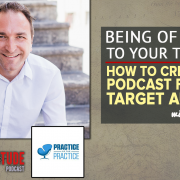“Everything rises and falls on leadership” is a phrase often heard in the startup and corporate arenas. As we’ve talked about in the past, leadership can be described by our influence on others. And with that influence automatically comes our business culture.
As creatives, we need to be aware of this culture that we’re building from the very beginning of launching our business.
Why is that?
Well, culture can be defined as a pattern of beliefs, behaviors, and values, encouraged or discouraged by people or processes over time.
So that means, whether we’re actively promoting a certain culture or not, one is being formed around the work we’re already doing.
So let’s talk a little bit about how we can get ahead of that culture as we’re scaling and growing our business.
It Starts with a Mission
Last week I had the opportunity to be part of a workshop called the Mission Roundtable. In this workshop, we focused on helping people in business find out what their personal and corporate missions were and then use that info to determine their values and vision. Once those were clear, we then set out to learn how we can create a unique strategy and culture for our business.
As you probably guessed, I was all about the part where we focused on determining our missions. This is something that I’ve thought about in quite a bit in the last year or so. In fact we recently had a guest on the podcast to discuss it.
Being part of this roundtable was not only clarifying for me, but also validated what I’ve been finding out.
For me, the reason I went into this research was fairly straight forward. As I’ve met more and more people in the entrepreneurial space, I’ve learned that many new entrepreneurs fail to learn how to connect who and what they’re about with the work that they’re doing.
The problem with this is that they’ll start doing one thing, realize they’re not being fulfilled, and then go on to try something else that might fulfill them.
Basically, they’re recreating a job for themselves.
Not only that, but many go hard core into this new role, go crazy with the grind, and come out the other end thinking “I’m more unhappy now than I was when I started!”.
Finding your own mission and being part of a company that reflects those qualities is an important foundation in doing meaningful work.
Vision and Values
Once we have our mission and have aligned it with our business (or the organization we’re a part of), then we can move onto the next step.
Determining what your vision and values are.
Now, I’m sure if you’re reading this post you know what both are. Your vision is simply where you want to be. And your values are the characteristics of yourself and your team as you get there.
If you’re like me, you’ve probably even written them down for yourself sometime in the past.
It’s possible what you haven’t done yet is to think of those values and your vision from the perspective of your personal and company mission. Even more, many of us might not even be fully using the vision or values we currently have in place.
If you’re not utilizing your current vision and values, why is that? Where’s the disconnect? If you’re not sure, it might be time to draw up a new vision and values to get you there. It might be as simple as the fact you might have a mission now, but the vision and values don’t fit that mission.
All of this should be aligned.
Strategy and Culture
Ok, now that we have those fundamental building blocks in place, it’s time to come back to our business culture and strategy.
Without vision, we can’t really develop a strategy. And without values, we’re going to have a heck of time developing a culture.
Now that we have those in place, though, we can now develop both.
Strategy
So first thing is strategy. Of course, when we’re developing a strategy for anything, we need to know what the rules of engagement are. We want to make sure the moves we’re making aren’t leaving anything on the table. We also want to make sure we’re being as efficient as possible.
To do that, we need guidelines.
Now that we have thought of our vision, we have these guidelines.
We should also know 3 things:
- What our company does.
- Who the customer is.
- What our customer values.
Once you know what those are, you can much more easily build your strategy.
- Of course you want to begin with the end in mind, so what do you want to achieve in 3-5 years?
- What options do you have to get there?
- After choosing an option, what are your next steps? Reverse engineer from where you want to be from where you’re at.
Many make the mistake of not being clear with the answers to these questions, so while you might be taking action, you’re not actually getting anywhere because you haven’t clearly planned out what you want.
Culture
When it comes to building culture, for many creatives it’s seen as something that they can put on the back burner. What’s the point of building a culture when it’s perhaps just you and a few VA’s?
While this perspective might seem ok when you’re first starting up, it can cause big issues in the long run.
However, because we’ve already developed our list of values, then getting an idea for what our culture is isn’t really too difficult.
Organizational Clarity
First thing? Let’s look at the big picture and get organizational clarity. Here’s a few things to consider:
- What’s our brand and story say about us? When people think of what we’re doing, what comes to mind? How are we described?
- What’s the structure of the team? If it isn’t formed yet, what will it be? Will there be a hierarchy? Will it be centralized with you in the center? Or will you be part of a decentralized team?
- What roles are there and what is each person in charge of? The more defined this is from the get go, the less problems there will be down the line.
- What’s our communication process?
Leadership Clarity
When it comes to leadership in our organization we need to lead by example. Do that and I think you’re at least halfway to being a great leader.
That said it also helps to make sure that our team can work autonomously. While we might want certain things done a specific way, it’s important that we don’t feel the need to constantly micromanage.
However, many times we aren’t always at the top. And in those instances, we have to be aware of where we fit and interact with those around us.
John Maxwell addresses this in the 360 Degree Leader. In the book, he shows middle managers how to leverage their unique positions and become 360 degree leaders by exercising influence in all directions–up (to the boss), across (among their peers), and down (to those they lead).
While he goes into much more detail, the gist is that we need to do a few things as a middle manager:
- Follow our leaders humbly. (Without being a yes man.)
- Inspire those around us (by example).
- Manage our subordinates individually. (Never criticize in public.)
- Influence Lovingly (Don’t have an ulterior motive.)
Relational Clarity
Finally, when it comes to where the rubber really meets the road, it’s all about relationships. Another book of John Maxwell’s (and a favorite of mine) is called Everyone Communicates, Few Connect. And really, the better our relationships with those around us are, the better the system works.
To make sure that we’re connecting with those around us in our work, it’s important to focus on a handful of principles here as well:
- Define and pursue the same goals (teams with goals win, those that don’t lose)
- Believe in something bigger than ourselves (believe you’re in it for the greater good!)
- Collaborate rather than compromise
- Develop strong relationships (care about others, they’ll care about you)
- When necessary, engage in constructive conflict resolution.
Action Steps
So as you can see, it’s imperative that we do the work to zero in on what our personal and business missions are. Only when we have them can we build on those to develop our culture. When we have the culture we want, it’s so much easier to build and scale our businesses simply because those folks who don’t fit, normally filter themselves out before they start working with you.
If they do fit the culture, then it’s so much easier to move forward and actually accomplish goals.
So, again, if you haven’t done so yet, start from the beginning and determine your own personal mission by checking out Uncover Your Personal Mission. From there, work out the other sections until you have an idea for how things are going to be handled differently by your current or future team.



